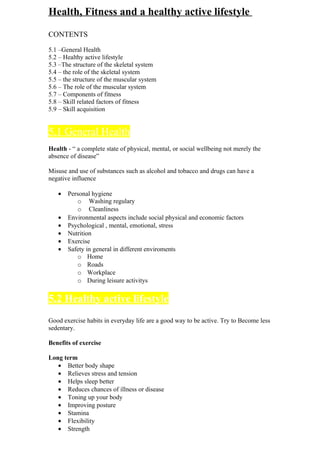
PEShare.co.uk Shared Resource
- 1. Health, Fitness and a healthy active lifestyle CONTENTS 5.1 –General Health 5.2 – Healthy active lifestyle 5.3 –The structure of the skeletal system 5.4 – the role of the skeletal system 5.5 – the structure of the muscular system 5.6 – The role of the muscular system 5.7 – Components of fitness 5.8 – Skill related factors of fitness 5.9 – Skill acquisition 5.1 General Health Health - “ a complete state of physical, mental, or social wellbeing not merely the absence of disease” Misuse and use of substances such as alcohol and tobacco and drugs can have a negative influence • Personal hygiene o Washing regulary o Cleanliness • Environmental aspects include social physical and economic factors • Psychological , mental, emotional, stress • Nutrition • Exercise • Safety in general in different enviroments o Home o Roads o Workplace o During leisure activitys 5.2 Healthy active lifestyle Good exercise habits in everyday life are a good way to be active. Try to Become less sedentary. Benefits of exercise Long term • Better body shape • Relieves stress and tension • Helps sleep better • Reduces chances of illness or disease • Toning up your body • Improving posture • Stamina • Flexibility • Strength
- 2. Short term • Increased heart and breathing rate • Increased body temperature • Reddening of your skin • A feeling of heaviness or tiredness in some of the muscles being used Guidelines and effects Physical condition – how healthy you are Long term aims – increase of activity over a long term basis 5.3 structure of the skeletal system Functions • movement • support • shape • red blood cell production • protection (MSSPB) Bones • LONG BONES o Femur • Short Bones o Phalanges • Flat (or plate) o Skull • Irregular bones o Vertebrae Joints • Hinge o Elbow o Knee • Ball and Socket o Hip o Shoulder • Pivot o Wrist • Condyloid o Wrist • Gliding o Bones in the hand Connective tissue • Tendons
- 3. o Muscles to bone o Very strong • Cartilidge o Buffer between joints • Ligaments o Joints to joints 5.4 The role of the skeletal system Joints • Freely moveable • Slightly moveable • Immovable Movements • Flexion o The decreasing of an angle at a specific joint, such as bending the arm at the elbow • Extension o The opposite movement to flexion, where the angle increases (as in the strike of a ball when the foot gets closer to the ball in front of the man) • Abduction o Movement away from the body’s centre (star jump start) • Adduction o Opposite to moving away from the centre body’s (Star jump return) • Rotation o where the limb moves freely in a curve such as the movement of bowling in cricket Articulation – A moveable joint between inflexible parts of the body 5.5 The structure of the muscular system Muscles 1. Skeletal muscles o “voluntary” o Biceps and pectorals are an example 2. Cardiac muscles o Involuntary o Only found in the walls of the heart 3. involuntary o walls of intestines and in the blood vessels Tendon- muscle to bone Ligament- bone to bone Origin- the end of a muscle attached to a fixed bone Insertion- the end of the muscle attached to a moving bone Prime mover- the initial muscle that contracts, AKA agonist Antagonist- the muscle that relaxes to allow a movement to take place
- 4. Muscles- are arranged in pairs, prime mover and antagonist because muscles can only perform a pull and not a push so work in pairs to aid this problem 5.6 The role of the muscular system Flexors – the muscles that bend at a limb, at a joint, by contracting Extensors- the muscle that works in partnership with flexor to straigten limb Adductors- The muscles that move a limb towards the body Abductors-the paired muscles for adductors which move away from the body Isometric contractions- muscles working to keep the joint stable like a handstand with isometric contractions in her arms Isotonic contractions- when the muscles become concentric ( muscle shortens) ; or when the muscles become eccentric (long) 5.7 components of fitness Strength • Dynamic strength o Support own body weight over a prolonged period of time or be able to apply force against a certain object • Explosive strength o Short, sharp, burst • Static strength o Greatest amount of strength been able to apply to an immovable object “ Hand grip dynameter” Speed - Reaction time + movement time Power - Speed + strength Standing broad jump Cardiovascular endurance “stamina” the ability of the heart and lungs to operate efficiently during endurance events 12 minute cooper run Multistage fitness test Flexibility “Suppleness” • Reduce injury • Improve posture Sit and reach test
- 5. 5.8 Skill related factors of fitness Agility -Flexibility and speed Illinois test Balance-The ability to maintain a given posture Stork stand Co-ordination- The ability to link all parts of movement onto one efficient movement Alternate hand throw Reaction time 1. Simple reaction time 2. CHOICE reaction time Ruler drop test Timing - Decision making + reaction time + co ordination Ambidextrous – The ability to be able to perform an action to the same standard with both hands Synchronise- an adjustment that causes something to happen at the same time 5.9 Skill acquisition Skill o Basic and complex Types of skill o Open and closed Types of guidance o Visual o Verbal o Manual Types of feedback o Intrinsic o Extrinsic Types of practise o Whole o Part o Fixed o Variable Knowledge of results – at end of the performance could be as simple as knowing the results Knowledge of performance- relates to the performance than the results